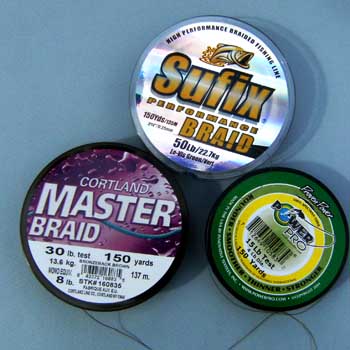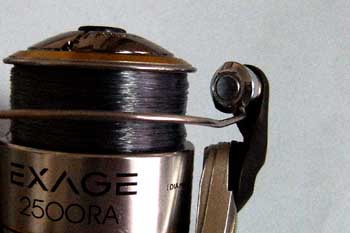These reels complicate the issue of loading line whilst avoiding twist simply because their method of casting and winding actively encourages twist. Little wonder some people call them ‘spinning reels’.
Try a little experiment sometime, if you get the opportunity. You want some narrow ribbon about 5 mm or so wide, the sort that you get around gifts. Tie the backing line of an half empty spool to one end of it and manually wrap the ribbon neatly and flatly around the spool.
Now, open the bale arm and take the leading end of the ribbon away from the spool, as if you were casting, taking ribbon off the spool. See how twisted it is? When you wind back on using the bale arm, much of the twist stays in the ribbon and next time you cast, the twist develops even worse.
Some lines can handle a certain amount of twisting very well, whilst other can’t, that’s why you get such varied opinions on the different makes of monofilament line. The reel manufacturers have tried hard over the years to eliminate twist, the big roller, then the grove in the roller that keeps the line to one side, ‘Twistbuster’ and ‘Aerowrap’, they all have their names.
However, a good idea is not to put too much twist in the line when you are loading it from a spool to the reel.
TYPES OF LINES
As with the centrepins, almost all types of monofilament and copolymer lines can be used on a fixed spool reel, but in addition, you can also use good quality braided lines. Just make sure that the braid you use is very cylindrical in it’s form and will not flatten under pressure when being wound around the bale roller because that can also cause line twist. Recommendations and/or experience will dictate which brands are most suitable.
The obvious use of braid is for spinning and lure fishing, but more recently they have been used for long distance feeder fishing and in carp fishing for feature finding. The benefits of braid is that is has very little stretch, as low as 1%, much lower than any monofilament. This means that you are always in direct contact with the fish and any end tackle, but it advisable to use rods that are considered to be soft so as not to damage the fish.
Good makes that are well recommended are PowerPro, Fireline, Sufix’s – Herculine, Matrix, and Performance, and one I have found very good recently – Cortland Master Braid. Braided lines also fall into two distinct types, governed by the fibre manufacturer. Dyneema fibres are manufactured in the far east and can be braided anywhere in the world, whereas Spectron can only be made and braided in the USA.
There’s not much to split them apart in terms of quality, you can get good lines in both types of line as the brands mentioned above prove. The Spectron fibres are often woven into sheet materials for the sails of yachts or layered together to make bullet-proof vests. About 24 layers are used and in tests, a 9mm sub-machine gun fired at a vest penetrated only 16 layers. It’s strong stuff.
Well, it’s strong when used like that, but it also suffers from abrasion on underwater rocks, so bear that in mind. It’s also strong in it’s breaking strain for it’s given diameter, for example, a 20+lbs braid will have about the same diameter as 8lbs monofilament. The other beauty of using braid is that it doesn’t suffer ageing and line setting the same as monofilaments, a line that has been on a spool for 3 years or more can often be turned around and used again for an equal length of time.
So, although dearer initially, braid works out cheaper in the longer term, but do be careful about how you use it and the applications you are putting it to. Also, don’t put too much braid on a spool, use only as much as you are likely to cast plus a little. And it’s always best to put a little monofilament on the spool first to stop the braid from biting onto the spool and, as has happened, distorting the reel’s spool.
ONTO THE LOADING.
It’s typical on fixed spool reels that, because they can cast much further, you nearly always use at least 100 yards or metres of monofilament. This is how most spools of line are sold in shops, in 100 metre/yard spools. It’s not always necessary to load a reel with so much, especially with expensive braid used for spinning where maybe 75 yards would do you and bear in mind that braid is likely to be sold in 150 yard spools.
Most reel’s spools are fairly deep and they’ll take far more than 100 yards, there are some shallow ‘match’ spools that will take about 100 yards, but otherwise you have to use a backing line. This backing line can be any old line from another reel, it doesn’t matter how rotten it is, it is unlikely to see the light of day again whilst fishing. If you haven’t got any old line, then buy some of the cheapest line you can find for the job.
Make the backing line thicker than the main line, this is just so you’re not using too much of it, but keep it in reasonably close in diameter to the line being loaded. For example, if you intend loading 4lbs line to use, then a backing line of 6 – 8 lbs would be ideal. A line of 15 lbs might be a mistake as some of the initial coils of your 4lbs line will just imbed into the spaces left between the 15lbs line.
By far the best way of holding the spool of line that is feeding the reel is so that the line will peel off the side of the spool. Do not stick it on a pencil (unless absolutely unavoidable) and let the spool turn as you take line off as this will encourage a certain amount of twist before you start. The spool must be held so that line comes off the side.
When it does this, it will come off that spool either clockwise or anti-clockwise. To know which way is the right way, look from behind the reel when it is being turned and hold it right up to the new spool of line. Most modern reels now turn their bale arm in an anti-clockwise direction, the old original Mitchell reels turned in an clockwise direction so if you still have one of those, do the opposite to what I am about to tell you.
The line must come from off the spool so that it flows straight onto the reel in the same plane. Take a look at the video to see what I mean. So, just to affirm this, the spool of new line should be held with it’s sideplate facing the reel and the line coming from it in an anti-clockwise direction.
When you will find this difficult, or even impossible, is when the spool of line has square sides (nuisance!) or worse still, there is a slit in the end plate to tuck the free end of the line into and the line keeps sticking in it. You will just have to put those on a pencil allowing the spool to turn and hope that it doesn’t impart too much twist on your reel.
On a fixed spool reel, the line should come to within one millimetre from the lip (see pic) of the spool, any more and you’ll get the line coiling off the reel. If you’re using braid make that within 2mm of the lip, braid will simply knot up if allowed to fall off the reel.
Another point that I will repeat in the third part to this series, try and soak braided line thoroughly before loading it. It helps it bed on the reel’s spool better.










